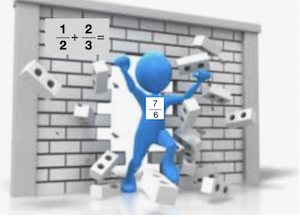
The problem many people have with school arithmetic [fractions] is that they never get to the meaning stage; it remains forever an abstract game of formal symbols.
Keith Devlin, The Math Instinct
This is particularly true when students are confronted with fractions. Not only are they overwhelmed by the myriad of rules one has to master, but they have to keep a stiff upper lip when facing problems like 1/2 + 2/3. Isn’t the answer 3/5? You would be surprised by how many kids think so.
If you do a Google search for how to learn fractions you get about 63 million hits. The top hit is a video titled Learn Fractions in 7 Minutes. The author must have a secret potion to serve students who have failed for many years of trying. After pressing the play button I notice that the video is 14 minutes long not 7. Already the author knows that 7 minutes is too short a time to learn fractions. 14 is definitely much better! (LOL) At the 6 minute mark the author is about ready to do division of fractions – the ultimate number-twister for students and adults since most can’t do division of fractions. It took him 14 minutes to complete his course. It’s a wonderful example of how NOT to teach fractions! On that depressing note, let me turn to something that I hope you will find more interesting and productive.
The way I see it is that we need to come up with ways that help children not only succeed with fractions but see their trip through school as an adventure which includes challenges that students will engage in because they are motivated.
Instead of making kids learn math, let’s make math kids will want to learn.
-Seymour Papert

One of the problems is that in contrast to units on whole number learning, topics in rational number concepts are usually covered quickly and superficially whereas focus on operations with fractions, decimals and percent get a lot more time.
While procedural competence is certainly important, it must be anchored by conceptual understanding. For a great many students, it is not.*
Curriculum as Story
Budget a bit more here rather than there, that choice speaks to your priorities about the way you define learning. And all of those decisions add up to a story. In fact, everything that you do in school contributes to a story that you are telling around learning and how you believe that happens. -Will Richardson
The story form is a cultural universal; everyone everywhere enjoys stories. The story, then, is not just some casual entertainment; it reflects a basic and powerful form in which we make sense of the world and experience. Indeed some people claim that the story form reflects a fundamental structure of our minds. Whatever the case, it is clear that children are readily and powerfully engaged by stories. -Teaching as Story Telling: An Alternative Approach to Teaching and Curriculum in the Elementary School, Kieran Egan
The Weird Number is a cartoon about an unnamed town nestled in the woods beyond the mountains inhabited by whole or natural numbers. 736 was the sheriff, 9 was the village baker and 1 was the mayor. At that time there were rumors that other strange creatures lived in the woods beyond the mountains. But no one could imagine that there could be numbers that weren’t natural. So they just ignored it and went about their business. The sheriff lives a quiet life because there are no robberies. You see (in this whole number inhabited town) if any resident would steal something, he would steal the same number of items as his name so they would be immediately arrested. Thus there were no robberies … until one day there was a robbery.
Watch the movie to see what happens next.
So begins the story that I hope will engage young children on their journey through fraction land and beyond. What are these creatures that live in the woods beyond the mountains?
The answer will be revealed in a mixture of story, fraction concepts and Scratch scripts. I hope it will engage young children to break through as they journey through this fraction adventure.
Stay tuned as the adventure unfolds.**
*How Students Learn History, Mathematics, and Science in the Classroom, Donovan, M. and Bransford, J., NAP, Washington D.C. 2005, p. 319.
**The adventure has unfolded. Here it is. Link.